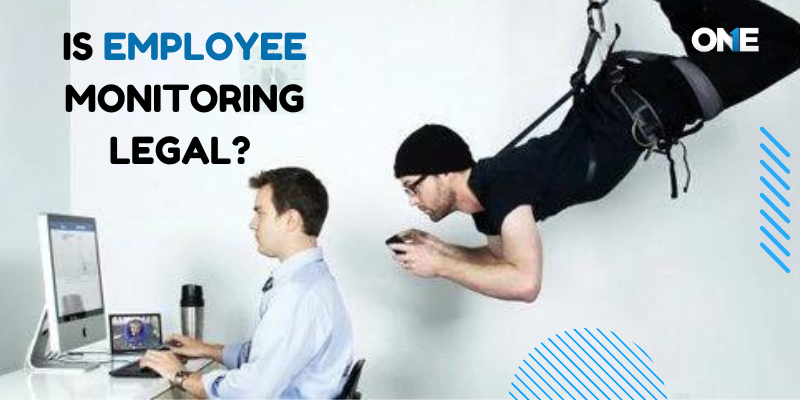Is employee monitoring legal? It is a controversial but legal practice. Many employers use it to track the activities of their employees. At the same time, it is not always popular. Monitoring employee behavior can help protect businesses from potential legal issues.
It will increase workers’ productivity. But what exactly is employee monitoring? How does it work? And most importantly, why is it legal? This article will look at all these questions. First, it will give you the best practices for implementing employee monitoring in your organization.
We will explore why employers monitor their employees—also the various methods and the laws governing this activity. We’ll also discuss effectively monitoring employees without crossing any legal lines without infringing on their rights. Finally, we’ll examine how businesses can use this information to improve performance and productivity.
What is Employee Monitoring Software?
Employee monitoring software can also provide employers with unique benefits regarding productivity tracking and analytics analysis. It allows them to evaluate performance and identify areas for improvement. Such software also gives employers visibility about when an employee is working or taking breaks. Suppose they’re socializing excessively or slacking off on their duties. By using such software responsibly, employers can ensure that their monitoring efforts remain within legal boundaries. At the same time, they are providing valuable insights into their workforce’s performance.
The Legal Requirements of Employee Monitoring
Employee monitoring is legally accepted as long as it adheres to certain requirements. As an employer, you must notify your staff when you plan to monitor their activity and explain why. You must also discuss the limitations of any electronic monitoring. Make sure employees understand their rights.
Employers can monitor company-owned devices used for work purposes such as computers and cell phones. The ECPA specifies that employers may install software and hardware that track:
- Employee emails
- Phone calls
- Computer usage
- App downloads
- Social media activities
However, employers have limited access to employee personal communication on these devices or privately owned ones. It’s only legal if the employee has consented or has an overriding business interest.
Common Reasons for Employee Monitoring Legal
After understanding the legalities of employee monitoring, it’s time to look at some of the common reasons employers choose to monitor their employees. Generally, monitoring is used to:
Ensure workplace safety/security:
Employers must ensure compliance with health and safety regulations. They should protect against workplace violence. Monitoring allows employers to detect potentially hazardous situations. That may occur onsite and can also be used to track employee movements and activity.
Increase productivity:
In most cases, monitoring will improve employee productivity. It helps in tracking key performance metrics. Such as time spent on specific tasks and frequency of breaks. So that employees who are not working efficiently can be singled out for further advice. It also allows organizations to understand their workflow and make administrative adjustments accordingly.
Confirm job requirements are, met:
Employers may use monitoring software to confirm that certain job expectations are met. Also, employees remain compliant with company policies. This is especially useful if the organization has many remote workers. Who are not physically present in the office. Through employee monitoring, companies can ensure their team is always working. When they should be and following all necessary protocols.
How to Monitor Employees Anonymously and Legally
Employee monitoring is a complex issue. But there are a few best practices that organizations can use to ensure they are legally monitoring employees. Anonymous monitoring is one of these practices.
Anonymous monitoring involves collecting data that does not personally identify any employee. It is widely accepted as a legal practice. Since it allows businesses to collect data without infringing on employee rights.
Here are steps to ensure you monitor employees anonymously and legally:
Use an anonymization tool:
Anonymization tools help strip any attached personal identifiers from data. It ensure it is truly anonymous and unlinkable. So that employees are not identified through their data.
Have a clear policy in place:
Setting out the rules for employee monitoring in advance helps ensure everyone knows what is and isn’t acceptable. This should be done through a clear set of policies and procedures. Which legal teams should review regularly.
Utilize tracking software solutions:
Tracking Software solutions such as TheOneSpy allow for accurate tracking of employee activities without compromising their privacy or security. Collecting or storing personal data, such as names or contact information, is unnecessary. By using the best software solutions, employers can create reports and audit trails with limited manual intervention. while still staying compliant with laws and regulations about privacy.
Why Is It Legal To Monitor Employees?
The legality of employee monitoring comes down to two primary factors. The employee’s right to privacy and the employer’s right to protect its interests. While employers often monitor employee behavior to ensure a safe, productive work environment. To protect company assets, employees need to know that their rights are being respected.
The issue can come down to a matter of understanding. When employees are fully aware that they’re being monitored, they can rest assured that their rights are still respected. While their employer is safeguarding their interests.
The Law of Consent
In general, employee surveillance is legal. So long as both parties have provided consent – i.e., the employee and the employer have agreed on the monitoring measures in question. As such, employers need to establish clear guidelines for what type of information will be monitored. How it will be used before any monitoring occurs. It’s also important for employers to provide employees with clear information about what data is collected and how it will be used, stored, and protected by the company.
How To Monitor Employees Activities Legally
The short answer to whether employee monitoring is legal is “yes,”. But the long answer requires understanding the specifics of how and why it’s legal.
Government Regulations
The government has passed laws that protect employees from intrusive monitoring practices. It clarify what types of monitoring can occur in the workplace. Employers must also comply with certain privacy laws in certain regions. Such as the GDPR in Europe.
Employee Consent
Employers must provide their employees with clear and concise guidelines about what types of monitoring are allowed. They must receive employee consent to monitor. If a company wants to monitor employee emails or other electronic communications, they must say so explicitly in their policies.
Notification
When employers do choose to monitor employees. They must notify those employees when that monitoring begins. Employees should be aware if their conversations are being watched. Or if emails are being tracked. This ensures that each employee has clear knowledge and understanding. About what is taking place under company policy.
How To Use The Results From Monitoring
When it comes to employee monitoring, the most important question may be. How do you use the information from the monitoring process? You can’t just collect it and leave it.
The data you receive from employee monitoring can provide a range of valuable insights. Such as:
- Employee productivity levels
- Time spent on each task
- Quality of work
- Compliance with company policies
- Safety procedures and practices
Your organization may use the results to understand employee performance better. Also to identify areas where further training may be needed,. It ensure you remain compliant with applicable laws and regulations. It’s important to use the data responsibly. Not to criticize employees unfairly. Ultimately, employee monitoring can provide greater transparency in your organization. It will lead to improved morale and efficiency.
What Are The Limits to Monitoring?
Employee monitoring is a complicated issue. Many rules and regulations are in place designed to protect the rights of the employee. You must notify your employees that their activities are being monitored.
You should keep in mind that the information you collect should be limited to only what is necessary. For performing the job duties of your employees. You should never collect personal information. Such as bank accounts, social security numbers, or other sensitive data. Similarly, ensure any conversations your employees have over company chat platforms remain confidential. It should be only relevant to their work.
You also have to consider any privacy laws at both the state and federal levels. When considering employee monitoring methods. Generally speaking, most states require employers to inform their workers. If they are being monitored and obtain consent. If they plan to collect any data related to their activity.
Finally, monitoring must follow company policy. This includes monitoring employees’ activities during working hours only. And not when off the clock. Unless it is explicitly stated in your company handbook that such actions may occur.
Conclusion:
In conclusion, employee monitoring is a legal activity. It is done in a way that respects employees’ privacy. Employers need to ensure that any actions are done in a transparent manner. It should be with clear guidelines and operational policies. It should outline why, when, and how monitoring activities are conducted.
Employers should also ensure that any information gathered is handled following the law. Employees should be aware of the restrictions and expectations set out in their contracts. By being aware of any data protection legislation. before they agree to any forms of monitoring. While employee monitoring can help promote a productive workplace environment. It’s important to ensure that it’s conducted with respect and integrity.







